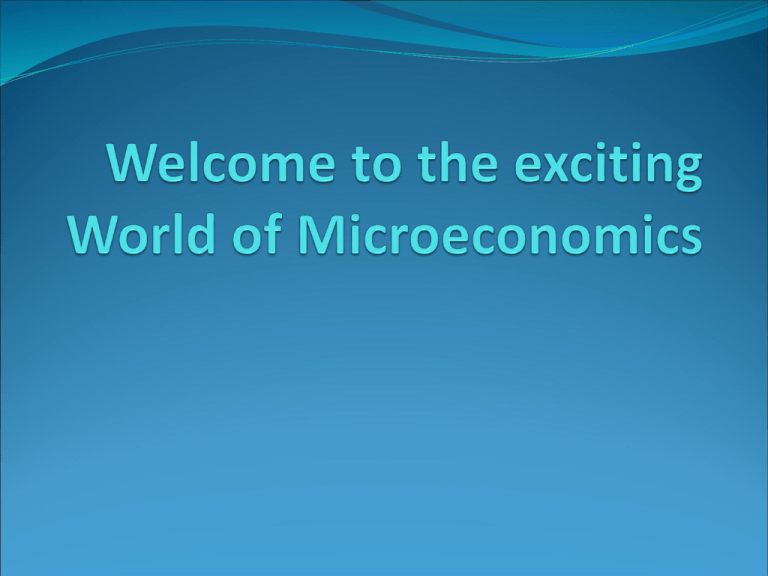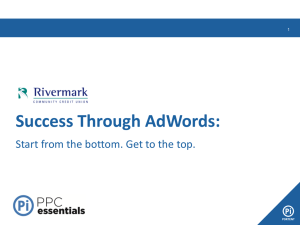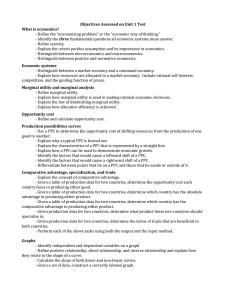to view the Chapter 1 Power point, Basic Economic Concepts.
advertisement

The Economic Problem Opportunity Cost Production Possibility Frontiers What is Economics? Nobel Prize Laureate Paul Samuelson's definition is as follows: “Economics is the study of how societies use scarce resources to produce valuable commodities and distribute them among different people.” Microeconomics – studies the interaction of individual components, the consumers and producers in the market; e.g., demand and supply, elasticity, costs of production of businesses. www.eportfolio.lagcc.cuny.edu/.../SSE103.html Macroeconomics – studies the functioning of the economy as a whole; e.g., taxation, Government spending, and changes in the money supply, interest rates, inflation rates and exchange rates. http://www.obamatoon.c om/photos/uncategorized /2008/11/16/20081120ob amatoon01.jpg Normative vs. Positive Economics Positive Economics – Describes facts in the economy. For example: Inflation is caused by an increase in the aggregate demand for goods and services. Normative Economics – involves value judgments. For example: The government should tax higher income earners more than lower income earners. What is the difference in the following statements? Arabianbusiness.com Friday, 29 August 2008 The dirham should be de-pegged immediately," said Khalaf Al-Habtoor, chairman of conglomerate AlHabtoor Group."The implications of the dollar peg have really begun to affect business and markets." http://www.arabianbusiness.com/505874-depeg-immediately-urge-uae-businesses The UAE is among four states in the GCC - including Saudi Arabia, Qatar and Bahrain - that are maintaining dollar pegs until they negotiate a single currency as early as 2010. http://www.arabianbusiness.com/516145-uae-fx-committee-recommends-sticking-with-dlr-peg Examine these pictures The Fundamental Economic Problem Unlimited Wants Scarce Resources TROPICAL TROUBLE EXERCISE Three Fundamental Questions of Economics What goods and services should an economy produce? – should the emphasis be on agriculture, manufacturing or services, should it be on sport and leisure or housing? How should goods and services be produced? – labour intensive, land intensive, capital intensive? Efficiency? Who should get the goods and services produced? – even distribution? more for the rich? for those who work hard? The Three Basic Economic Questions How does a market economy decide: WHAT to produce? HOW to produce the goods and services? FOR WHOM to produce the goods and services? Factors of Production Factors of production are the inputs or resources used to produce output (goods and services). Land anything that comes from the geographical surface of the earth. Land’s reward is rent. Labor all the mental and physical effort used in producing goods and services Labor’s reward is wages. Capital all man-made resources used to produce goods and services. Capital’s reward is interest. Enterprise the individual(s) who come up with the business idea, take the risk and organize the other factors. Enterprise’s return is profit. The workings of a Market Economy How do businesses decide: WHAT to produce? HOW to produce the goods and services? WHO gets the goods and services? The Circular Flow of Income Model Circular Flow of Income with Government and International Trade Choice and Opportunity Cost Opportunity Cost Opportunity Cost is the best , or most valued, alternative you give up when making an economic decision. Choice? Opportunity cost? Choice? Opportunity Cost? Choice? Opportunity Cost? Choice? Opportunity Cost? Production Possibilities Curves (PPC) A PPC shows the combinations of goods and services that an economy can produce using all its resources fully. EUROLAND’S PPC Euro Land's PPC Production Possibilities A B C D E Cars (000) 16 12 8 4 0 Mobile phones (000) 0 12 24 36 48 Constant Opportunity Cost & PPC EURO LAND’S PPC - A straight line PPC shows constant opportunity cost. CARS (000s) C 8 D 4 24 36 Mobile Phones (000s) PPC & Constant Opportunity Cost JAPAN’S PPC Japan's PPC Production Possibilities A B C D E F Capital Goods (000) 0 1 2 3 4 5 Consumer Goods (000) 500 475 425 325 175 0 PPC & Increasing Opportunity Cost : JAPAN’S PPC Capital Goods (000s) 3 D C 2 325 425 Consumer Goods (000s) Discuss the points and the following PPC I Why is the PPC bowed out from the origin? The PPC is bowed out from the origin b/c of increasing opportunity cost. Opp cost increases b/c to get more of one good an econ. has to give up more and more of the other good b/c resources are NOT equally efficient at producing both goods. PPC and Economic Growth Improve quality of resources; i.e., training & education Increase quantity of resources;i.e., discovery of new oil reserves Technology to increase productivity Increase # of women in the workforce More Research & Development (R & D) Produce more capital goods today PPC and Economic Growth Capital Goods Y1 Yo C . A B Xo X1 Consumer Goods BENEFITS OF TRADE Trade between nations allows countries to OBTAIN combinations of resources that are greater than they can produce. Trade does NOT mean economic growth. Summary: Production Possibility Frontiers Show the different combinations of goods and services that can be produced with a given amount of resources No ‘ideal’ point on the curve Any point inside the curve – suggests resources are not being utilised efficiently Any point outside the curve – not attainable with the current level of resources Useful to demonstrate economic growth and opportunity cost Review 1) Complete the Problems for LO1 2) Applying your Knowledge and Understanding Read the passages and: Look up any new vocabulary words. Apply the concepts learned in LO1 REVIEW PROBLEMS Review Problem Production Possibilities Cars x-axis Computers y-axis A 16 0 B 12 16 C 8 28 D 4 36 E 0 40








